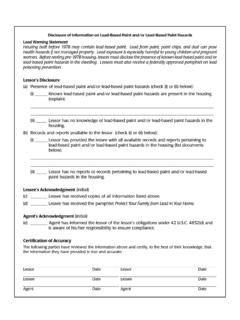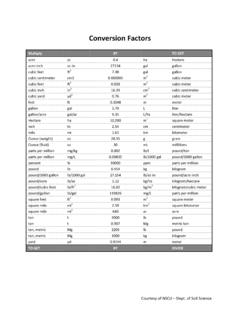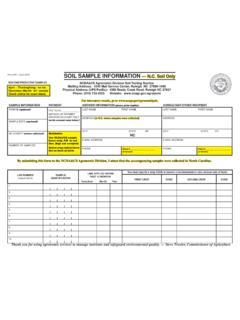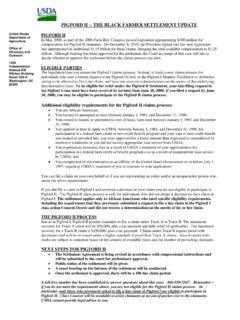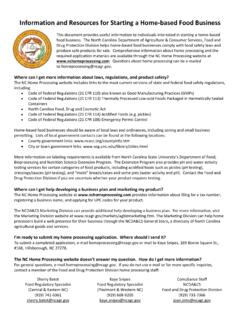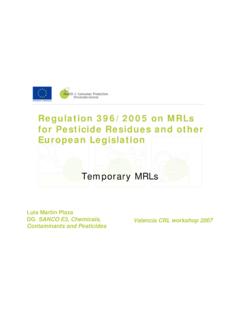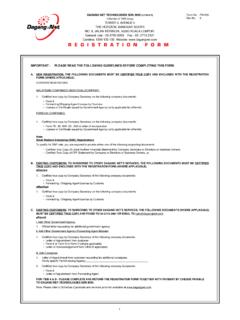Transcription of The Worldwide Importance of Pesticides for Crop …
1 The Worldwide Importance of Pesticides for Crop Production Leonard P. Gianessi CropLife Foundation Tropical Export Crops Bananas, cocoa, coffee, tea Perennial trees/bushes that cannot survive freezes Diseases, insects, and weeds flourish in the tropics Without Pesticides , production would decline significantly Bananas 34 billion pounds exported annually Most popular fruit in the world Sigatoka fungal germ tube penetrating opening in banana leaf Sigatoka-infected banana plants Bananas: Sigatoka Disease Present in all banana growing countries In 1934, destroyed 22,000 acres of bananas in Central America Fungicide treatments began in 1936 Treated Untreated Banana Export Plantations: Today Fungicides are applied 25 35 times annually Pesticide Use Markets Highly developed (>90% acres treated) US, Europe, Japan, Australia, Canada Developing China, India Not Developing (<5% acres treated) Sub-Saharan Africa Pesticide Use Driver: Developed Countries Consumer demand for picture-perfect produce Consumers have zero tolerance for wormy apples apples have been sprayed with insecticides for over 100 years Cherry Fruit Fly Cherry Fruit Fly Larvae Supermarket Shopping Survey Two-thirds of respondents were willing to pay 5 10% higher prices for certified pesticide-free produce, yet were unwilling to accept any cosmetic defects or insect damage.
2 ERS, USDA, 1990 Herbicide Use Driver: Developed Countries Shortages of workers to weed fields starting around the 1950s-60s Herbicides greatly reduced the need for weeding by hand California: Weeding Vegetable Crops 1940s 1960s Thousands of legal temporary workers from Mexico in the Bracero (Strong Arm) Program Millions of people weeded cotton fields into the 1950s Hand Weeding Decline in Hand Weeding 1950s - 1960s Millions of Workers Left Southern States for Urban Factory Jobs The Bracero program ended in 1964 Hand Weeding Was Replaced with Herbicides Pesticide Use Drivers: Developed Countries Need to produce more food for growing populations Pesticides have effectively controlled pests leading to yield increases Population, 1900 - 2000 0501001502002503003501900191019201930194 0195019601970198019902000 Millions05010015020025030019101920193019 4019501960197019801990200020101950 = Farm Output Aggregate Farm Input Use 0501001502002503003504004505005501910192 0193019401950196019701980199020002010195 0 = Aggregate Farm Input Use 0501001502002503003504004505005501910192 0193019401950196019701980199020002010195 0 = 100 LandLaborMachineryChemicals0500010000150 0020000250003000035000400004500019001920 1940196019802000 Lbs/ AcrePotato Yield: US Synthetic chemical Pesticides introduced Rice: Weeds Not Well Controlled Before Herbicides Hand Weeders Not Used Untreated Herbicide Treated Herbicide Application.
3 Rice Rice Yields Acre Herbicides Introduced Herbicide Adoption Complete Pesticides are used widely in agriculture in the United States. Their application has improved crop yields and increased the quantity of fresh fruits and vegetables in the diet, thereby contributing to improvements in public health. NAS, 1993 Feeding a Changing World Increased Population Rapid Economic Growth Increased Urbanization Increased Middle Class Changing Diets China s Population 020040060080010001200 UrbanRural199020102050 FAO Millions Weeding Rice, China Moody, 1991 Adequate weeding of rice requires 1 billion person days of labor Hand Weeding in China Millions of Farm Workers are Moving to Urban Areas Herbicide Use: China Million Hectares China: Rice Field Weeding Rice in India Labor is becoming scarce India: Crop Herbicide Market Phillips McDougall Middle Class Households Dwyer, 2012 China.
4 Beef Production FAO US Soybean Exports to China 895 million bushels/year 50% of all US soybean exports 25% of total US harvest 50% of China s soybean imports United Soybean Board Soybeans Since 1976, 95-98% of US soybean acres have been sprayed with herbicides for controlling weeds. USDA, NASS. Weeds in Soybean Field Untreated Herbicide Treated Cultivation of organic soybeans with 30 inch row spacing Michigan State University: Research Trials Cultivators Can t be used in wet fields Weeds continue to grow Wisconsin Research: Weeds and Yields The frequency of weed control problems and subsequent reduced yields in low-input row crops is roughly 34 out of every 100 cases and the corresponding relative yield is approximately 74% Posner, et al, 2008 In the there is a perfect non-chemical alternative to herbicides. Weeding a community garden In the U. S.
5 70 million workers would be required for weeding to prevent yield losses without herbicides. Gianessi and Reigner, 2007. Brazil: Soybean Production 01530456075195219621972198219922002 MillionTonsFAO Soybean Rust Pustules Brazil: First appeared 2001 By 2003: Spread to entire country Yield losses up to 75% Yorinori, 2005. Brazil: Spraying Soybeans Fungicides prevent losses of 44% Scherm, et al. 2009. Brazil: Soybean Fungicide Market 2520060060080002004006008001000200120032 00520072009 MillionUS$Phillips McDougall Africa: Maize as traditional food Main food for 50% of the population. 65% of farms have shortages before next harvest. Maize Yields (Tons/hectare) Africa Global FAO Gray Leaf Spot on Maize Leaf Maize: Africa, Fungicides Sprayed Unsprayed Fungicides increase maize yields 27 to 54% Verma, 2001. Africa Transformed Rural to Urban Sub-Saharan Africa: Urban Population 0200400600800100012001990200020102020203 020402050 MillionsFAO Africa: Potato Consumption Potato Production: Sub-Saharan Africa FAO 1990 1994 1998 2002 2006 2010 Production Area Yield 1990= Kenyan Highlands Potatoes: Africa, Fungicides Sprayed Unsprayed Namanda,et al, 2004.
6 Fungicide spray increases yield by 224% Hand Weeding is the Predominant Weed Control Practice in Sub-Saharan Africa 50-70% of the labor in crop production is spent weeding Chikoye, et al. 2007. Constraints on Timely Hand Weeding Women can be too tired or sick (malaria) Fields can be muddy Competing time demands: child care Pregnancy African Weed Control: Current Practice 100 million hectares, 100 million women 200 hours/hectare 20 billion hours 20-100% yield loss Gianessi, 2009. Crop Life Zambia Training Program 3,200 spray service providers were trained. Hillowitz, 2010. Spray Service Provider: Zambia 300% increase in herbicide sales in Zambia. Hillowitz. 2010. Maize yield increased from tons per hectare to as much as tons per hectare. CARE Zambia, 2011 Adoption of herbicide technology among female farmers has also brought behavioral change as most of them have vowed never again to weed their crops using hand hoes.
7 CARE Zambia, 2011 China would undergo famine if Pesticides were not used . The warning has come in a recent Chinese Ministry of Agriculture AGROW, 2012 Japanese Rice Famines due to rice blast 1695, 1783, 1833 1837 Last major rice blast outbreak : 1953 Fungicides have prevented outbreaks since then Rice blast Oku, 1994. Monument to fungicides for rice blast control in Nankoku, Japan Conclusion Pesticides are Essential for Feeding the World A significant increase in pesticide use would greatly improve international food security Weedy Crop Field: Africa Weedy Crop Field: Africa Uncontrolled Weeds: A Major Cause of Hunger Visit Us At.


